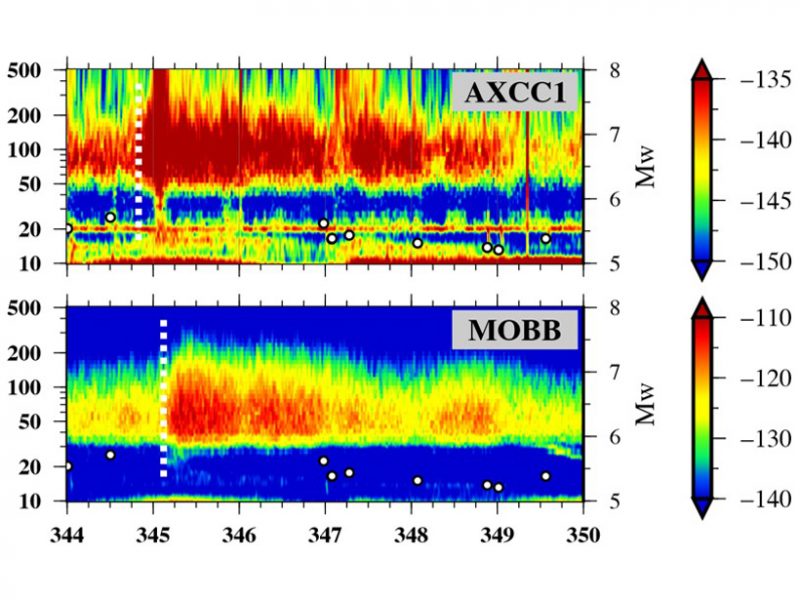
本周发布的为美国地球物理联合会AGU EOS (Earth & Space Science News) 的最新Editor's Highlight和美国、新西兰、瑞典、德国、加拿大地区的PhD, Postdoc, 访问学者的招聘信息。本周还内附NASA Frontier Development Lab的实习机会哦!欢迎关注我们!
Editor's Highlight:
Follow The 'Hum': The Seismic Signal of Pacific Ocean Storms
Have you ever noticed that the Earth is humming? Seismologists have! Discover how individual storms in the northern Pacific Ocean generate a long-period seismic signal.
SOURCE: Geochemistry, Geophysics, Geosystems

Plots of power spectral density (a measure of how much energy is present at different frequencies) at ocean bottom seismometers AXCC1 (top panel), located offshore Cascadia, and MOBB (bottom panel), located in Monterey Bay, California. The x axis represents time, labeled as days of the year 2015, while the y axis represents wave periods, in seconds (labeled at left). Colors indicate the power spectral density in decibels (dB), with red colors indicating more energy and blue colors indicating less energy. The dashed white line indicates the first appearance of strong energy at relatively long periods due to a storm impacting the Cascadia region of the west coast of the United States. Small gray dots indicate the timing of relatively large earthquakes globally, with the size of the earthquakes (on the moment magnitude scale, Mw) shown on the right side of the plot. Credit: Maurya et al. [2019], Figure 5 lower right panels
The Earth's "hum" is an enigmatic, low-frequency signal that has been known to seismologists for some time, but whose source has remained poorly understood. It is generally thought that the hum is generated in ocean basins through the interaction of infragravity waves with the seafloor. However, the hum is not evenly distributed in space or time, and the exact mechanisms through which it is generated remain unclear.
Maurya et al. [2019] combine seismic observations with ocean wave height data to track two large storms in the Pacific Ocean and delineate how each of them generates hum. Their work shows that the distribution of Earth's hum sources strongly depends on the propagation characteristics of the corresponding storms and how the storms interact with the coastline. This study has important implications not only for how we understand the generation of infragravity waves in the ocean, but also for studies of deep Earth structure that take advantage of the hum signal.
Citation: Maurya, S., Taira, T., & Romanowicz, B. [2019]. Location of seismic "hum" sources following storms in the North Pacific Ocean. Geochemistry, Geophysics, Geosystems, 20. https://doi.org/10.1029/2018GC008112
—Maureen Long, Editor, Geochemistry, Geophysics, Geosystems
国外学习、实习、工作机会:
1. Postdoc-Understanding Habitability of Redox-Active Hydrothermal Systems in Planetary Environments
Pasadena, California (US)
Jet Propulsion Laboratory
2. PhD Opportunity-Volcano Geophysics
Auckland, New Zealand
School of Environment, University of Auckland
https://findajob.agu.org/job/8009514/phd-opportunity-volcano-geophysics/
3. NASA Frontier Development Lab Intern 2019
Mountain View, California (US)
The SETI Institute
https://findajob.agu.org/job/8009522/fdl-intern-2019/
4. PhD position in crop production adaptations to climate change
Uppsala, Sweden
Swedish University of Agricultural Sciences, SLU; Department of Crop Production Ecology
https://findajob.agu.org/job/8009511/phd-position-in-crop-production-adaptations-to-climate-change-/
5. Visiting Assistant Professor of Earth and Oceanographic Science
Bowdoin College, Brunswick, ME
Bowdoin College; Department of Earth and Oceanographic Science
6. PhD Position (m/f/d) In the Area of Air-Sea lnteraction
Geesthacht, Schleswig-Holstein (DE)
Helmholtz-Zentrum Geesthacht (HZG)
7. Postdoctoral researchers in Earth Systems Modeling
College Station, Texas
Texas A&M - Oceanography Department
8. Postdoctoral Scholar
Flagstaff, Arizona
Northern Arizona University School of Informatics, Computing, and Cyber Systems
https://findajob.agu.org/job/8009504/postdoctoral-scholar/
9. Postdoctoral Researcher in Climate & Marine Ecosystem Modeling
Portland, Maine
Gulf of Maine Research Institute
10. PhD Position working on Algal Bloom Predictors
Waterloo, Ontario (CA)
Lake Futures Research Project at the University of Waterloo
https://findajob.agu.org/job/8009508/phd-position-working-on-algal-bloom-predictors/
11. Distinguished Postdoctoral Scholar
Miami, Florida
Florida International University
https://findajob.agu.org/job/8009507/distinguished-postdoctoral-scholar-/
责任编辑:孙佳悦